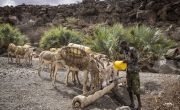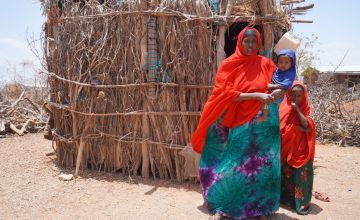
Knowledge Hub
The ongoing conflict in Ukraine. Rising energy prices. Political turmoil. Climate change. There is a lot going on in the news agenda, and not everything will get the screen time and column inches it deserves. But there is a crisis in East Africa that desperately requires and deserves our attention and action.
East Africa is currently experiencing its most severe drought in 40 years. A staggering 23 million people across Ethiopia, Kenya and Somalia, and 7 million people in South Sudan - most of whom are already living in extreme poverty - are acutely food insecure. This is when a person's inability to consume adequate food puts their lives or livelihoods in immediate danger.
It is expected that this year, 5.7 million children across Ethiopia, Kenya, Somalia and South Sudan will be acutely malnourished, with more than 1.6 million of them expected to be severely acutely malnourished, and famine is a very real possibility in Somalia.
Regrettably, this situation could have been averted had global leaders, the international community and donors paid heed to the warning signs and warnings from aid agencies over the past year.
A history of drought
Sadly, East Africa is no stranger to these devastating conditions. In 2011, severe drought affected 13 million people across the region, with Somalia suffering the most as conflict exacerbated the situation. In July that year, famine was declared in Somalia, with 260,000 people dying - half of them children under five.
A slow response to the crisis was criticised as donors and leaders failed to act on warnings as early as 2010 that famine could break out, with 3.7 million people at the time experiencing crisis levels of food insecurity. In 2017, famine was averted in East Africa thanks to improved responses to 2.9 million people facing crisis to emergency levels of food insecurity, but it seems that history is repeating itself.
This current drought has been induced by La Niña, or an intensification of normal weather patterns. This atmospheric phenomenon causes ocean surface temperatures to cool down as winds strengthen and blow warm water towards the west, and causes either heavy rainfall or drought, depending on the geographical location.
La Niña is not an effect of global warming, but climate change has meant that the reliability of La Niña-induced rains has decreased in recent years. East Africa has now experienced three consecutive failed rainy seasons, with a predicted fourth failed rainy season expected to have devastating consequences.


A bad situation made even worse
Most people in East Africa are farmers, and are reliant on the land and their livestock to survive. So when drought strikes, there is an immediate impact on their ability to work and feed their families.
For example, in Kenya, a drought emergency has been declared with between 80% and 90% of reservoirs and dams drying up in Turkana, its largest county in the northwest of the country and one of the hottest and driest counties in Kenya. Here, lakeside communities can no longer survive on fishing, while pastoralists are losing their livestock.
More than 1.4 million animals are believed to have died in Kenya alone as a result of the ongoing drought, with the government bringing in and slaughtering more than 75,000 weak livestock in order to share meat with more than 766,000 households in the worst affected areas.
Arshad Muhammad, Concern’s Kenya Country Director, explains: “It’s very worrying when even camels, known for their ability to survive in extremely hot and dry conditions, are struggling to survive.”
East Africa’s dependence on agriculture would make severe drought difficult enough to weather, but a number of factors have exacerbated the situation. As previously mentioned, climate change has not caused the drought, but has made it worse and prolonged the conditions. This is despite the region being one of the least responsible for climate change, being responsible for just 0.1% of global carbon emissions.

And while it may be happening thousands of miles away, the conflict in Ukraine is having a disastrous impact on countries including Ethiopia, Kenya and Somalia by creating a perfect storm for food insecurity. Ukraine and the Russian Federation are among the world’s “breadbaskets”, in that they provide around 30% of the world’s wheat and barley. Thirty-six countries import more than 50% of their wheat from Russia and Ukraine, including Somalia, and this has led to food prices rocketing in these countries in particular, as well as Sudan and South Sudan.
According to the Food and Agriculture Organisation’s Food Price Index, global food prices reached an all-time high in March 2022, and on average, the cost of a local food basket has increased by 23% across East Africa in one year. Even worse, Ethiopia’s cost of a food basket has risen by 66%, with Somalia’s rising by 36% between February 2021 and February 2022.
Fertiliser supplies and cost have also been impacted by the conflict due to Russia and neighbouring Belarus providing one fifth of the world’s fertilisers, and even if rains return to the Horn of Africa, pastoralists could struggle with next year’s harvest due to a lack of fertiliser imports.
All of these shocks - plus conflict, locusts and Covic-19 - have left East Africa on the verge of a humanitarian catastrophe. According to a new report from Oxfam, Save the Children and the Jameel University called Dangerous Delay 2: The Cost of Inaction, it is estimated that one person is likely dying of hunger in Ethiopia, Kenya and Somalia every 48 seconds.
Aid agencies have been warning of the catastrophic consequences from the moment the long rains failed last year across the Horn of Africa, and have called for urgent action from as early as May 2021. Then, there was not much of an appetite for a response at a time when the situation was considered not to be severe. Sadly, we have now reached a point where what will shock us or get our attention are images of emaciated babies and animal carcasses. And that – I am sorry to say – is utterly repugnant.
What we're doing in Somalia, Kenya and Ethiopia
Somalia
A severe drought is looming in Somalia. This risks the number of people needing urgent humanitarian assistance escalating rapidly in the coming weeks. The number of people affected by drought has risen from 4.9 million in March to about 6.1 million in April.
Due to conflict, insecurity, drought and floods, an estimated 1 million people have been displaced in Somalia, of which 2 million are children. In April 2022 alone, over 25,000 people were displaced by drought, and in the previous month 7,000 people were internally displaced by conflict.
Worryingly, as of 20 April, six areas in Somalia are facing the risk of famine in the coming months. Without sustained humanitarian assistance, more than 6 million people are facing severe to near-complete food shortages between now and June.
Ethiopia
Kenya
Concern's response
Concern is responding to this crisis supporting health clinics to deliver nutrition assistance and providing emergency cash transfers to affected communities. This allows beneficiaries to afford nutritious food to feed their families.
Our teams are also repairing broken boreholes and shallow wells and vaccinating livestock against diseases in an attempt to keep them alive during the drought.
We are continuing our work to improve access to adequate and safe water, largely through ground water abstraction infrastructure and enhanced adoption of sustainable water resources management practices in both developmental and humanitarian emergency contexts.

However, the crisis in East Africa will require a $4.5 billion commitment globally for an effective humanitarian response in the region.
Amina Abdulla, Concern Worldwide’s regional director for the Horn of Africa, explains: “Shockingly, we are fast heading to where we were in 2011. Many of us will remember the scale of the drought in East Africa back then, the number of lives lost, and the length of time it took the humanitarian community to launch an appropriate response and help support communities to the point where they could recover.
“For families struggling to feed their children today in parts of Ethiopia, Somalia and Kenya, there is not a moment to lose. The response is already six months too slow. We must act now.”
We’re fighting to prevent the situation getting worse, but we need your help.
Other ways to help
Donate now
Give a one-off, or a monthly, donation today.
Join an event
From mountain trekking to marathon running, join us for one of our many exciting outdoor events!
Buy a gift
With an extensive range of alternative gifts, we have something to suit everybody.
Leave a gift in your will
Leave the world a better place with a life-changing legacy.
Become a corporate supporter
We partner with a range of organisations that share our passion and the results have been fantastic.
Create your own fundraising event
Raise money for Concern by organising your own charity fundraising event.





